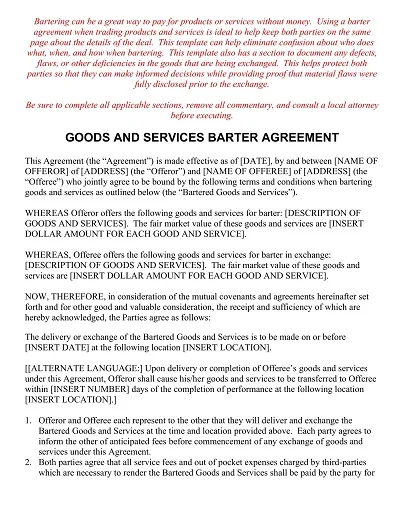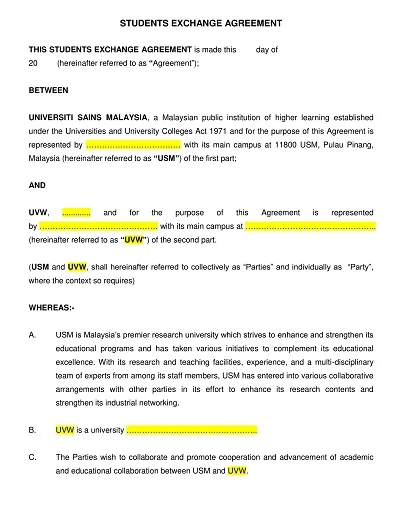
A Barter Agreement Template refers to a typically written document prepared in advance and employed to detail the conditions of a swap transaction with another party.
Contents showIt generally involves statements such as the exchanged object or service, the value of the object or service, the time frame of the exchange, and any other features necessary to ensure that the exchange is legal and proper, particularly where the two parties have no contractual relation.
This template is essential to investors or organizations involved in barter exchange as it ensures proper communication in non-barter water cases.




A Barter Agreement is a commercial contract in which two or more individuals trade to deliver goods and services without using cash. This system benefits the participants by allowing them to use assets they already own to get things they want from the other party, thus constituting an exchange of value.
In the contractual nexus, the facts often mentioned are the goods or services exchanged, their quantity, and the relative delivery date or terms, all to avoid transaction ambiguity and protect each participant’s interest.




A barter arrangement gains its most importance when components, like a direct exchange, have qualities that would benefit the parties involved in transacting without money.
Here are some specific instances where a Barter Agreement is applicable:
Some of the benefits of trading goods and services, especially for a new or small business with little or no cash, are utilizing cash for other activities and acquiring essential goods and services.
Suppose a company has some raw materials or products that it does not need to use immediately. In that case, it can sell them in the market and acquire other products or services that it requires, which, in a way, will transform the excess material into a valuable resource.
Bartering remains an effective way of creating new business partnerships because it puts these companies in situations where they must provide value for each other and form partnerships.
Bartering is quite useful for enterprises that seek entry into a new market since this allows the business to subject its products or services to market conditions by way of an initial no-risk offer without putting a lot of money into advertising or sales.




It remains efficient in numerous situations, particularly when the specific and successive exchange of goods or services with other individuals or trade partners can meet the desired needs without necessarily using the medium of money.
Below are specific instances where a barter agreement is beneficial:
Contracts assure each party that it will supply the other with services or goods as agreed without spending cash directly; this is ideal for start-ups or businesses experiencing cash shortages.
Barter can help companies use excess production or surplus stocks. Rather than being put out of active use, resources can be traded for other needs in operations.
Exchanging warrants and goods can assist in forming and developing business partnerships. It fosters symbiosis and collective development as member organizations work for the mutual benefit of all.
Barter is also useful in cases where the company has to explore new markets. Barter trade helps the business organization advertise and enter new markets without making a heavy investment.
This contract is quite flexible, whereby the agreement period, the agreed value exchange terms, and the items exchanged can easily fit the needs and limits of the business world, making it a very useful tool.
Elements of a Barter Agreement include:
It is important to appreciate that a barter agreement has several benefits for business entities and individuals. One can decide whether to engage in one based on the above-highlighted benefits derived from the agreement.
Barter is another way of trading whereby one can avoid spending cash because instead of paying for goods, a person exchanges his or her goods. This may prove especially helpful during situations of financial strain or for business owners with little initial capital.
One of the key benefits of barter is that through the trading process, entities can effectively use resources that would otherwise be idle. Inventory that is not selling or services that are not in demand can then be exchanged for a product or service that would be of more use, hence using the maxim that ‘time is money’, no capital outlay is used to acquire the other good or service.
Trade involves exchanging goods and services, which can help create strong relations between business partners. As it is in bartering, the involved parties learn more about the other person’s business needs, capacities, and reliability, laying the foundation for further business partnerships.
From bartering, businesses are usually exposed to different markets and customers that were unknown to them initially. Barter has significant advantages as when businesses exchange products or services, they reach out to their counterparts and, therefore, potential customers through the partnership, hence having a large market without necessarily having to advertise.
This may be particularly true in certain regions where barter transactions are recognized as coming with specific tax benefits. However, anyone contemplating such a move should always consult a tax advisor. Funds received as consideration must be stated as income, while the cost of the goods or services given must also be recognized; however, barter sales’ are generally more advantageous from a tax perspective than cash sales are.
Describing the procedure of developing the Barter Agreement Template requires consideration of the following essential steps. Hence, both parties gain value, and the agreement becomes enforceable.
Here are the details to include in your template:
A workable and general Barter Agreement Template based on these points would enhance the exchange process and make it more productive.